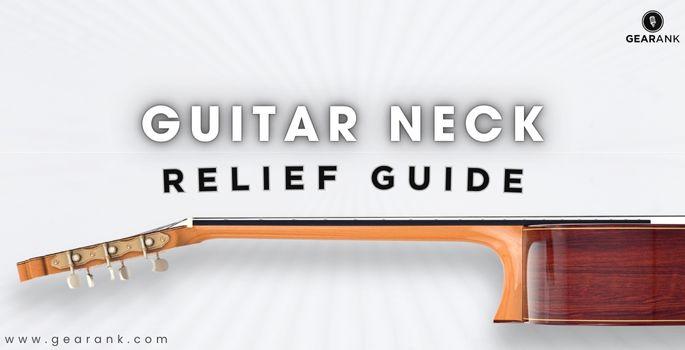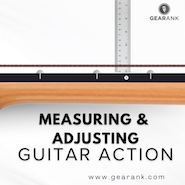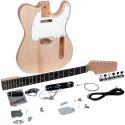Guitar Neck Relief Guide

Neck relief is a term that comes up frequently when discussing guitar setup, whether it's an acoustic or electric guitar.
Proper neck relief results in a comfortable playing experience without annoying fret buzzing or string rattle.
In this guide, you will learn what neck relief is, its importance for your guitar, and how to set it up in just a few easy steps.
Here, you will learn:
-
What Is Neck Relief?
-
How to Check and Adjust Your Guitar's Neck Relief
-
Why Is Neck Relief Important?
-
Tips To Maintain Your Guitar's Neck Relief
By the end of this guide, you will learn what neck relief is and how to adjust it to improve your guitar's setup.
What Is Neck Relief?
It's a common belief that guitar necks should be perfectly straight, but that's not the case. A guitar with a straight neck creates buzzing sounds near the nut, and playing sustained notes can be challenging. A slight curvature or bow in the neck is ideal for a guitar's sound and playability.
The curvature in your guitar's neck is known as neck relief, creating a small gap between the strings and the 12th fret. This gap allows the strings to vibrate freely, producing a sound that resonates better.
Two types of neck relief provide varying amounts of curve to your guitar's neck. These are:
-
Concave Bow or Up Bow: This refers to the guitar neck bending upward.
-
Convex Bow or Back Bow: This refers to the guitar neck bending downward.
The difference between these two is more pronounced when you play your guitar.
How to Check and Adjust Your Guitar's Truss Rod
To check the neck relief on your guitar, place a capo on the lower frets, specifically, the first fret, and press on the last fret or where the neck meets the body.
Measure the distance between the low E string and the seventh or eighth fret using a feeler gauge or a ruler that measures inches/millimeters. The amount of relief depends on your preference, but for most guitars, it should be around 0.127 mm to 0.508 mm (0.005" to 0.02").
Additionally, consider the neck radius, as shown in this table by Fender.
Fender Stratocaster, and Telecaster Fender Bass
NECK RADIUS Neck RELIEF NECK RADIUS Neck RELIEF
-
7.25" .012” (0.3 mm) 7.25" .014” (0.35 mm)
-
9.5"-12" .010” (0.25 mm) 9.5"-12" .012” (0.3 mm)
-
15"-17" .008” (0.2 mm) 15"-17" .010” (0.25 mm)
Use a hex wrench or an Allen key when adjusting your guitar's truss rod. The truss rod is used to achieve the ideal amount of neck relief. Turn the truss rod clockwise to decrease neck relief and counterclockwise to loosen and increase it. Make small adjustments, and perform it in a place with good lighting, and no distractions, so you can focus on the changes you are applying to the one guitar you are working on.
-
If your guitar has an excessive bow in the neck, known as an upbow, you can correct it by turning the truss rod clockwise and lowering it.
-
In contrast, if your guitar has a backbow, turn the truss rod counterclockwise to correct it.
Reminder: When adjusting the truss rod, turn it in small increments and check the guitar's neck curvature after each turn to avoid damaging the neck.
Why Is Guitar Neck Relief Important?
Having the right amount of neck relief is crucial for smooth guitar playing. It allows the strings to resonate freely without requiring too much effort.
In contrast, more relief than normal can make fretting difficult, while less relief can result in string buzzing.
Neck relief is a vital guitar setup component and necessary for electric and acoustic guitars.
Tips To Maintain Your Guitar's Neck Relief
-
Regular Inspection: It's essential to regularly check the neck relief by looking down the edge of the fretboard for a slight curvature. If it seems excessively bowed or too flat, it may need adjustment.
-
Temperature Control: Maintaining consistent temperature and humidity levels is essential when storing your guitar. Use a humidifier in dry conditions or a dehumidifier in humid conditions, and consider storing it in a cabinet.
-
String Maintenance: It is essential to change your guitar strings regularly, as old and worn-out strings can cause uneven tension on the neck. Additionally, the type and gauge of strings can affect neck relief, so choosing strings suitable for your playing style and guitar is important.
-
Maintain Stable Action: Maintaining a comfortable and stable action or string height is important to ensure optimal performance. Changes in the string height, whether higher or lower, can also impact the neck relief. You can also adjust action by tweaking neck relief. You can adjust the bridges and saddles for electric guitars to adjust the string height. Acoustic guitar bridges can be filed or shimmed to make necessary adjustments.
-
Setup: It's important to note that other factors, such as string action and string gauge, affect playability. While learning truss rod adjustments is valuable, seeking professional assistance is recommended when in doubt.
Final Thoughts
To play comfortably without fret buzz, it's important to have good neck relief. When adjusting the truss rod, pay attention to the curvature of your guitar's neck.
Adjust the truss rod in small increments and check the neck relief after each turn.
Keeping your guitar in a controlled environment and performing regular maintenance checkups is also crucial.
A guitar with a balanced neck relief will have a longer lifespan since a well-settled neck is less prone to wear and tear.
Frequently Asked Questions
Can I damage my Guitar by Adjusting the Neck Relief?
Minor adjustments to the neck relief are generally safe, but over-tightening or loosening the truss rod excessively can potentially cause damage to the guitar. When in doubt, seek professional assistance.
How often should I check and adjust neck relief?
Checking and adjusting neck relief frequency depends on string changes, climate variations, and playing habits.
To ensure optimal playability, it is essential to check the neck relief periodically. Specifically, if you notice any playability changes or switch to a different string gauge, checking the neck relief is a good idea.
What Are Other Factors That Affect Neck Relief?
Truss Rod Adjustment: Tightening the truss rod of a guitar can cause a convex bow while loosening it can cause a concave bow.
String tension: The strings exert the most pressure on the neck. As a result, the neck tends to curve slightly upwards, which is known as an upbow.
Removing the Strings: Strings serve as a counterforce to a truss rod's pull in the opposite direction, and removing them from your guitar for an extended period can cause the neck to warp.
Temperature: A guitar's body is affected by seasonal temperature changes since it is made of wood, which expands or contracts based on the weather.
Contributors:
- Jerome Arcon - Co-writer
- Jerry Borillo - Illustrator












